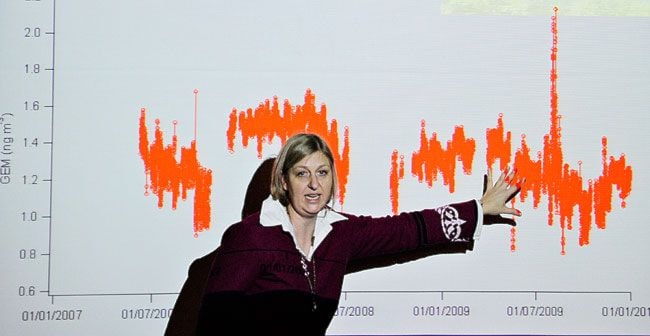It has taken five months, two international environment conferences and numerous emails for a scientist who has been doing work in the Yukon to be allowed to speak to the News.
In December, the News was invited to a Yukon College lecture on pollutants in the Yukon’s air by Environment Canada scientists Hayley Hung and Alexandra (Sandy) Steffen. Steffen has been measuring mercury levels in the air from a station at Little Fox Lake since 2007.
But when the News asked if it could also interview the pair, it was turned down, mostly because federal Environment Minister Peter Kent was in South Africa at a climate change conference.
This week Steffen was among about 3,000 other participants at the International Polar Year conference in Montreal.
And much to the News’ surprise, the same communications officer who had rejected the paper’s interview request in December, contacted the paper to see if there was interest in talking to Steffen and other scientists at the conference.
The News accepted the invitation, only to discover that when it comes to mercury in the air, the Yukon has little to worry about.
“Levels in the Yukon are quite low, nothing to be concerned with,” said Steffen in a telephone interview from Montreal on Wednesday.
Mercury can be deadly to humans who are exposed to high levels for long times. People suffer from mercury poisoning after eating too much mercury-rich fish, like tuna.
But mercury is a natural part of the world.
The Yukon has quite a few underground deposits of mercury off the North Canol Road, near the N.W.T. border, which Steffen has studied in the past.
But mercury likes floating in the air best, she said. It is released into the air by volcanoes and significantly by forest fires - which are common in the territory.
Man-made mercury emissions are also a growing concern internationally. The United Nations is working on a global treaty to reduce mercury emissions.
Improperly disposed of florescent bulbs, metal smelting, incinerators, even crematoriums, can give off mercury emissions.
But the most significant contributors are the coal-fired plants in Asia, just across the Pacific.
Steffen said their Yukon project is studying how much mercury those Pan-Pacific winds are bringing to Western and Northern Canada and the U.S.A.
Trying to differentiate between the sources of airborne mercury found at Little Fox Lake is still a challenge, she said. That is partly why continuing to monitor mercury levels is so important, despite the fact that current levels are not a risk, she said.
Whitehorse-based Environment Canada biologist Mike Gill was also put up for an interview with the News from Montreal this week.
Gill, who specializes in birds, is the chair of the international network called the Circumpolar Biodiversity Monitoring Program.
One of its most recent reports is pegged to the Arctic Species Trend Index. It was able to include 37 per cent of all known Arctic fish, mammals and birds.
Since the last index in the 1970s, populations of marine mammals, like the bowhead whale, have been increasing, largely due to a recovery from historic hunting.
But new numbers for sea birds are alarming.
There was an increase in populations until the mid-‘80s but ever since they’ve been in decline.
Gill said there could be multiple reasons for this but one concern is major development in Southeast Asia. This has taken over crucial habitat for the migratory birds that need a place to touch down, rest and feed.
“Those (seaside habitats) are pretty critical because those birds can’t just keep flying past those areas, they need to stop and feed,” said Gill.
“And with that pretty rapid habitat loss, concurrently we’ve seen some big declines in a number of migratory bird species in parts of Eastern Siberia, so along that flyway.”
As well, just over half of 36 populations of sea-ice species studied, like ringed seals and beluga whales, have been in decline since the last 1970s index.
There isn’t quite enough information to determine why just yet, but those species have been identified as a priority for future study.
Fish populations, on the other hand, have increased - or at least they did until the mid 1990s, especially in both the Pacific and Arctic oceans. In the Atlantic, fish numbers have mostly dropped.
But there was a significant link discovered with some fish, said Gill.
Pelagic fish, those fish that live closer to the top of the water, have a strong relationship to Arctic oscillation - the changes in things like climate and atmospheric pressure felt in the Arctic, as the Earth tilts on its axis.
In general, the warmer the temperature, the stronger the species are.
“This is really an important finding,” said Gill. “It actually helps nations’ fisheries managers, and so forth, predict, over time, what those stocks of fish might be doing - based on information they get from climate conditions and sea-ice pressure in the Arctic.”
Despite information from this recent index, scientists are far from knowing enough to manage Arctic fisheries carefully, said Gill.
While in Montreal, more than 2,000 scientists from nearly 70 countries signed an open letter calling for a moratorium on commercial fishing in the Arctic until more research can be done.
A lot of the unknowns come from the fact that those species have been hidden by ice until now.
The Arctic is a sensitive ecosystem, Gill added, and no scientist should assume they know everything they need to about it.
The common thread between much of the research presented in Montreal was that the Arctic needs good stewardship.
But there are no assurances that this stewardship will be guided by science in the future because this conference marks the end of the International Polar Year.
Contact Roxanne Stasyszyn at
roxannes@yukon-news.com
